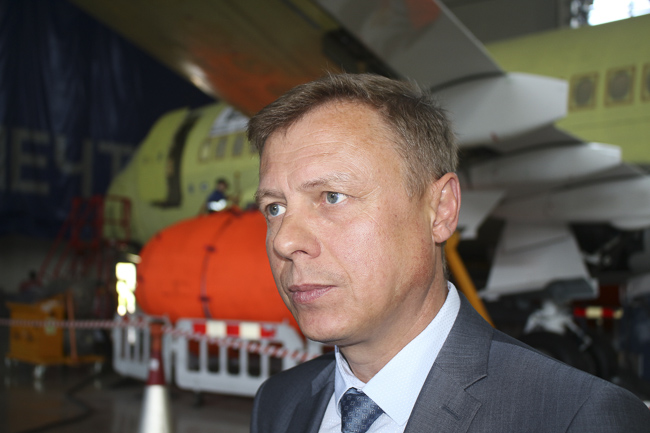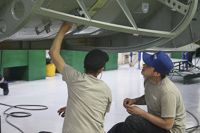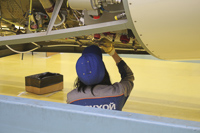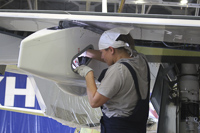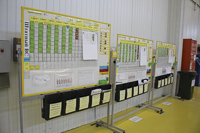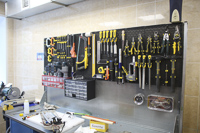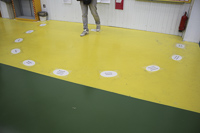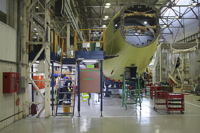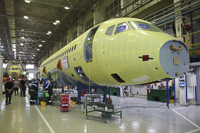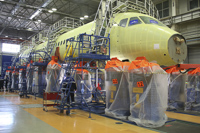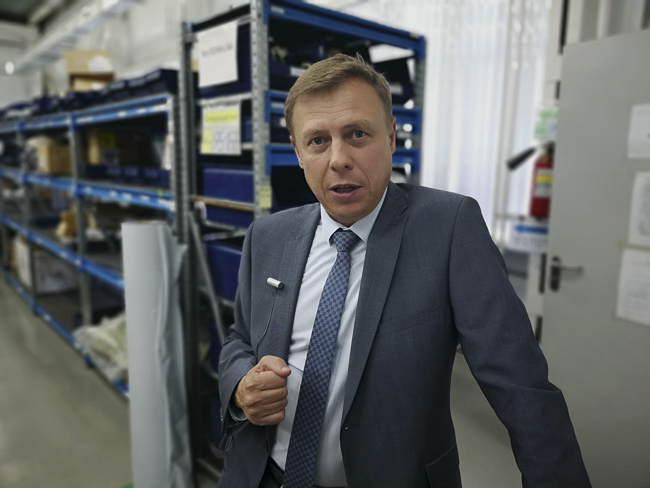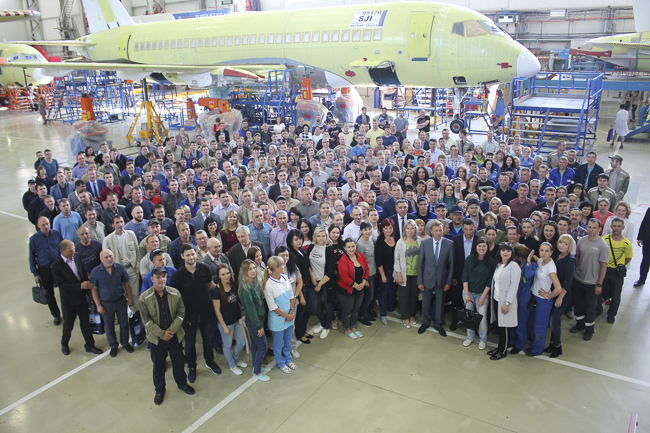- Dmitry Vladimirovich, ten years have passed since the first flight. The press materials of the company have all the results, but I want to ask you about this. During those ten years, since the first flight, have all of the Superjet 100 projected in the project implementation plan been implemented? Maybe something did not work out, maybe, on the contrary, did not expect and it turned out?
- Very quickly, these ten years have flown by. As I remember now, this plane still stands at the start before the eyes, the heart flutters, the plane is in the air. And now we must sum up the results of the decade. I really do not like the word "results" in this context, since the results suggest the end of something, suggest some point. No point. Here the conversation can not even go on about the comma, because this is only the beginning of the development of the project. Of course, we did not achieve all that we wanted ten years ago. But they did not expect to go the whole way of the program. And the program is in its prime. The most important thing is that we managed to build production and production systems that meet international standards. We managed to show that we are ready and able to produce as many aircraft as we need to meet the needs of the market. That is, we managed to go through the entire initial stage of the project to organise production and reach the most important stage of it - production, sales and after-sales service.
- What difficulties did you encounter during the project implementation?
- Like any program, at the stage of pilot production we encountered design difficulties. There was a large number of constructive changes that had to be picked up on the fly and implemented in the aircraft already under construction. After there were experienced aircraft, we went on to certification. A very large amount of certification work was done on this aircraft, I would even say an unprecedentedly large amount. But coping with these difficulties, we faced the following: the deployment of mass production and the increase in output.
At the initial stage, we annually doubled the production of aircraft. It was difficult, but we did it. Today you see a modern production system corresponding to the world level, which allows us to build quality and competitive aircraft. Of course, as in any machine-building enterprise, there were technological difficulties, and their development was required. By itself, the assembly of the aircraft is a technologically very complex production. You have seen what complicated equipment is used in the assembly, for example, docking stands. Not just so we had to use these stands. They provide high accuracy of positioning of aggregates relative to each other. But they also make very large demands on these units themselves. They also need to be manufactured with high accuracy in order to ensure high-quality docking. Yes, we had at the first stage of complexity with the provision of these parameters. To date, the main technical issues on the aircraft have been resolved, and we are no longer faced with them in the production cycle. If we did not solve them, we would not be able to collect the aircraft in seven days.
After all, we used to assemble the first airplane for a whole year. Then we were happy that we went out to produce one aircraft a month. Today we have reached the figure of five to seven working days and produce 34 aircraft a year. Of course, the set goal can be achieved in different ways. You can recruit many workers, build another building and, through this, get a doubling of production. This way is extensive. But this is a great cost and high cost. And it is possible, to go the intensive way, as we did - to achieve an increase in production by changing the production system, introducing a system of lean production and without capital-intensive costs. The introduction of a system of lean manufacturing produced tremendous results. This was the essence of success - the annual doubling of production without a set of additional workers. And you can see the results yourself.
If we are talking about lean manufacturing, we should always understand that we have two basic concepts: value and loss. We need to determine the values for customers, and everything else, in fact, oddly enough, is a loss. And we must work to eliminate these losses. This all sounds very simple, clear and seems easy. In fact, all this is very difficult, because here we are faced with the restructuring of the consciousness of the collective. And this is the most difficult thing. It is impossible to simply implement the toolkit that you see, when everything is marked, everything is in its place. It is so worth it not because journalists arrived today. I assure you, no one specially cleaned and cleaned up. Do yourself a favour, come quietly without warning and you will see exactly the same picture. This is the daily normal state of production.
After all, we used to assemble the first airplane for a whole year. Then we were happy that we went out to produce one aircraft a month. Today we have reached the figure of five to seven working days and produce 34 aircraft a year. Of course, the set goal can be achieved in different ways. You can recruit many workers, build another building and, through this, get a doubling of production. This way is extensive. But this is a great cost and high cost. And it is possible, to go the intensive way, as we did - to achieve an increase in production by changing the production system, introducing a system of lean production and without capital-intensive costs. The introduction of a system of lean manufacturing produced tremendous results. This was the essence of success - the annual doubling of production without a set of additional workers. And you can see the results yourself.
If we are talking about lean manufacturing, we should always understand that we have two basic concepts: value and loss. We need to determine the values for customers, and everything else, in fact, oddly enough, is a loss. And we must work to eliminate these losses. This all sounds very simple, clear and seems easy. In fact, all this is very difficult, because here we are faced with the restructuring of the consciousness of the collective. And this is the most difficult thing. It is impossible to simply implement the toolkit that you see, when everything is marked, everything is in its place. It is so worth it not because journalists arrived today. I assure you, no one specially cleaned and cleaned up. Do yourself a favour, come quietly without warning and you will see exactly the same picture. This is the daily normal state of production.
- That is, one of the main purposes of lean production is saving money, not only temporary, but also human efforts, and financial losses in the process of work.
- This is not the goal, but the result. The philosophy of Lean suggests that the result will come. The philosophy of Lean says that it is necessary to deal with the elimination of losses, and the result will come of itself. It is necessary to identify losses, that we do superfluous, that does not bring value to our product. And when we start thinking in these categories, we come to a very simple idea that the leader, no matter how interested he may be, can do nothing by himself, because he does not collect airplanes himself. He needs those people who work directly with their own hands to understand and implement this very Lean-management, and implement it in their daily activities. The main thing is not the floor in the shop, not the ceiling, and not even the planes standing in the shops. The main thing is people, this is the collective, this skeleton that thinks in Lean categories, which understands what the leaders are talking about, and picks it up and realises it. Who himself works for development. On the development of the company, on the development of the project, on the development of the enterprise. That's the most important thing.
- We have heard about another technology of lean manufacturing - Kaizen philosophy. At what point and why did you decide to implement it in production here in Komsomolsk?
- Somewhere in 2011-2012. This is the beginning of the introduction of Kaizen. Before it was necessary to grow. That is, it is impossible to come to any backward enterprise and say: "And now Kaizen!" No. First, the concept of flow should appear, the concept of repeatability should appear, and this is the most important thing. And then you can do Kaizen. Today Toyota has achieved seven Kaizen from a person a year. We have achieved one and a half. The best enterprises in America are three. So it's unlikely that anyone will be able to outdo Toyota. It would be strange if someone in Japanese philosophy was better than the Japanese themselves. To understand what the conversation is about, we need to grasp the base - it's repeatability. Each day should be similar to the previous one. The days should not be different. It's like in the movie "Groundhog Day". For example, the first day of tact on an airplane should not be different from the first day of tact on the next plane. When you get the repeatability, when you build the streams, then you get Kaizen. And then you start to think about what is behind the "Kaizen"? And behind the "Kaizen" is the understanding of the PDCA cycle: plan, do, verify and standardise.
- You involve workers in the very essence of the production process. Can a worker become an administrator?
- A worker can, and this is quite a frequent occurrence. It is clear that this is education. We have the deputy director on manufacture is a former worker. He started working, today he is deputy director. The head of the department of production management also started working. If this worker has the qualities of a leader, it is a future controller or a master. And then everything depends on education. The basis of the team of specialists is made by graduates of local higher educational institutions. Of course, the basic for us is Komsomolsk-on-Amur State Technical University. He has a faculty of aircraft construction, and graduates of the faculty form the backbone and support of our enterprise.
We have a program of work with this university. We together with it the so-called basic chair is opened. That is, students, students of the Department of aircraft construction within the framework of the basic department are practicing with us at the enterprise. This practice is not just as it used to be a one-month summer practice. This is a practice for a year. It is allocated specially one day a week, when they come to the enterprise, they work, they receive the initial knowledge. And this work is paid. Including, on vacation we take them and practice. We formally employ them. Decent working conditions and decent wages, that's what attracts people to our company. And further we try to give them an opportunity to realise their creative aspirations and creativity. About this is not accepted today to speak in Russia, more and more about money, but creative realisation for the individual, for the specialist, this is a very important motivation.
- Now a lot is said about the next stage of the development of the aircraft and its new modifications. In your opinion, is it possible to increase the percentage of composite parts in Superjet aircraft and whether it is necessary to chase the composite as such?
- In no case should we chase the composite as such, because we are making a product, we are making a product that should be in demand on the market. In order for it to be in demand on the market, it must, firstly, meet the technical characteristics that the airlines need. The second - it should, of course, meet the economic requirements of airlines. And here at this junction it is important to find the balance between technical difficulties, between technical risks, and the possibilities that the composite gives us. At one time, when this project began in the early 2000s, then it was decided that the technical risks of large use of composite materials are too high. We stopped at a fairly reasonable, at that time, from our point of view, the scope of their application. But at the same time, today science has gone ahead. Today there are proposals for a composite wing, for a wider use of composites in the design of the fuselage. All this is carefully considered by the company "Sukhoi Civil Aircraft", and some of it will be used, including on a 75-seat aircraft, which is currently being developed.
- If we talk about the 75-local version of SSJ, I would like to know about the production capacity. According to the SCA, the production site of the branch in Komsomolsk-on-Amur is designed to produce 40 aircraft a year. Last year, 34 aircraft were built. Where will the SSJ75 be built? Do not need new production buildings?
- Being explored different options but the basic option is a variant of aircraft built here in Komsomolsk-on-Amur, on the same production facilities to reduce the financial burden on the investment, which will be on the program of the new aircraft. It is assumed the possibility of producing both a cell model, and the 75th, that is on the same production sites will be held or the hundredth, or 75 minutes. Accordingly, hundredths will be less as much as will be more than 75's.
- What will be the difference of 75 SSJ from SSJ 100 in addition to passenger capacity, started in principle to concrete work on this project and is there any assessment of market demand for these aircraft?
- The company is already working on creating a new version of the aircraft - 75-seat. Work has begun with Russian scientific institutes and a technical task is being formed. Potential operators discuss those characteristics that would be preferable for them. We already understand today that these will be requirements for the weight of the structure, in the field of aerodynamic quality, in the field of fuel efficiency. An agreement of intent with the airline S7 has already been signed, and it is regarded as the main starting operator. The 75-seat Superjet will be different from the basic version. There will be significant differences along the wing, some differences on the fuselage. On the engine to a lesser extent, at this stage the application of the same SaM146 is considered, with minor improvements. There will be a difference in avionics, in terms of the composition of the component parts, some of which will be imported. In the Russian segment, the need for such aircraft is about 200-300 units, the entire world demand is 3 thousand aircrafts.
- What is the fundamental difference between the Superjet 100 and the Superjet 100R project? Alexander Rubtsov said that in version R there will be more Russian components.
- On this plane now everything is still at the stage of elaboration. We determined which parts can be replaced, and we work with Russian suppliers. I would say that it will be avionics, interior and life support system. But I can not name specific Russian manufacturers yet, because suppliers are determined in a competitive environment by competition. We stated that we need such and such technical characteristics, such economic characteristics, and the possibility of certification. Those enterprises that can provide all this with the best results, we choose.
- How long will it take, according to your estimation, to implement the Superjet 100R and Superjet 75 project from the beginning of the terms of reference, the technical design, to rolling out and before the first flight? In the industry it was said that from the moment of starting the technical specification to rolling out or even the first flight, the Superjet 75 can pass 4-4.5 years. Is this a realistic date?
- Yes. Everything will depend heavily on those technical solutions that will be worked out, implemented at the stage of preliminary design. After that, we can clearly name the time frame when we will finish the project part of the program. Approximately this will become clear by the end of the year.
- Will it be difficult to retrain people to assemble a new aircraft?
- It will not be so different from the point of view of assembly. There, of course, there will be nuances, but it will not be difficult to retrain people. It was much more difficult to create a team capable of building civilian aircraft. It was very difficult. It took a reorganisation of consciousness, We must ensure that all indicators are on top. The main thing is not just to make a plane, but to make it quality, safe and economical.





